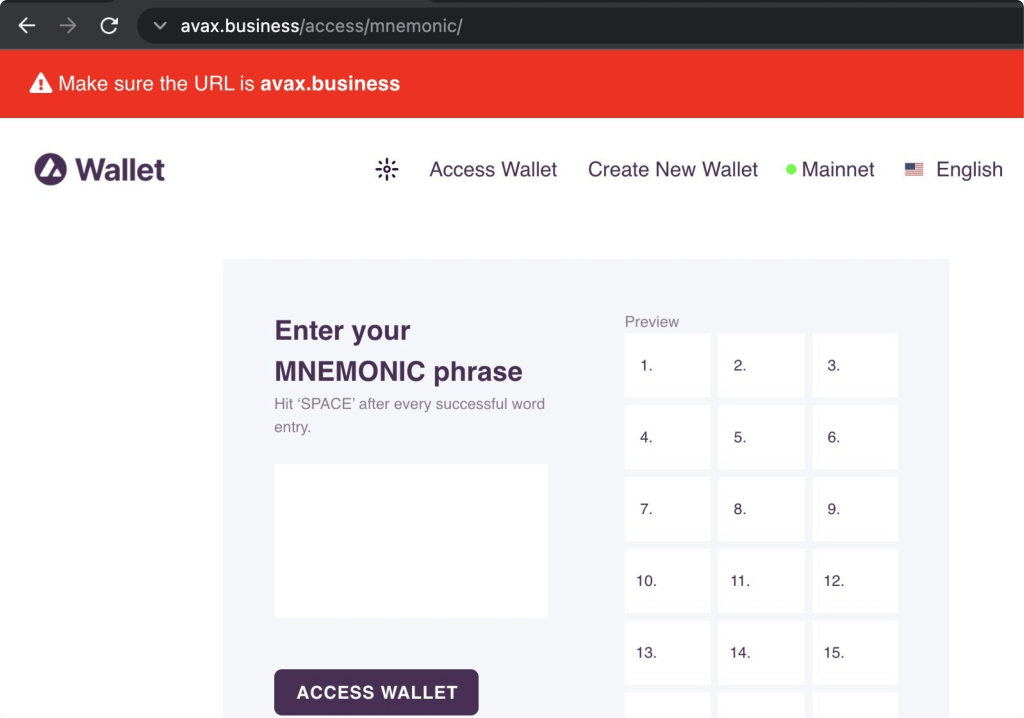In the ever-evolving landscape of digital security, user account safety is our top priority at BTSE. We leverage advanced security protocols to guard your account and funds. Yet, it’s critical to stay vigilant and exercise caution to thwart potential fraud. This article uncovers the hidden traps of phishing attempts, online scams, and fraudulent activities that can catch even the most cyber-savvy off guard.
Common Phishing Scams
Domain / Website Lookalike (Copycat)
Cybercriminals often create a website that visually looks identical or very similar to the legitimate one. For instance, if the real BTSE domain is “btse.com”, the scammer might use “btse.net” or “btse.biz”. Their meticulous mimicry can extend not only to the website’s domain but also to its layout, content, and images.
They may even resort to the deceptive use of special characters, which can bewilder the average user. For instance, “citibank.com” and “citibαnk.com” may appear strikingly similar but lead to entirely different destinations. Can you spot the subtly altered ‘α’?
Users may be redirected to these fraudulent sites through deceptive emails, ads, or even manipulated search engine results. Please avoid websites without the official btse.com domain!

Example of Domain / Website Lookalike: A fake Fantom home page
Fake NFT / Coin / Airdrop Claims
Beware of fraudsters offering free Non-Fungible Tokens (NFTs), crypto coins, or airdrops as part of a ‘special promotion’ or event. A common tactic is to ask users to click a link to claim their ‘gift’. Unfortunately, these alluring paths often lead to phishing sites that lure users into revealing their wallet credentials.

Example of Fake NFT / Coin / Airdrop Claims: A fake Solana airdrop event
Fake Technical Support
In this ploy, fraudsters masquerade as technical support agents, using scare tactics like issues with your wallet that need immediate attention. They may ask for your credentials or trick you into clicking a link leading to a phishing site.

Example of Fake Technical Support: A fake PancakeSwap support page
Airdrop with Fake Social Media Site
Airdrops are commonly advertised on social media. Scammers may create counterfeit social media pages mirroring real ones to promote fraudulent airdrops. They’ll request followers to share their wallet addresses or private keys to participate, exploiting this information to pilfer funds.

Example of Airdrop with Fake Social Media Site: A fake Flux social media page
Fake Online Wallet
Scammers can be audacious enough to create fake online wallet services, often baiting users with irresistible offers like high yields on investments. Once the user deposits their funds, the criminals vanish with the money.

Example of Fake Online Wallet: A fake AVAX wallet
Using Social Engineering and Phishing to Seize Discord Servers
In Discord servers, especially those related to crypto or NFT communities, scammers may pose as admins or staff. They typically allege an issue or update and trick users into clicking a link or disclosing their credentials, all with the aim to hijack servers or steal user information.

Example of Using Social Engineering and Phishing to Seize Discord Servers
What to Watch Out For
A cautious click: Hover your mouse over links in emails or the address bar to reveal the actual web address. Is there a mismatch or suspicious link? It’s a red flag.
Spot the slip-up: Look out for spelling errors or grammatical mistakes in emails or websites. Legitimate organizations have content experts to ensure their communication is polished and professional.
Urgency undermining tactics: Scammers frequently create a sense of urgency to make you act quickly. High-pressure tactics? It’s likely a scam.
Attachment alert: Avoid opening attachments from unknown sources. They could be infected with malware ready to compromise your device.
Seeing is not believing: Scammers can convincingly mimic official logos, fonts, and other details. An official-looking website or email isn’t always legitimate
Direct dialogue: If you have any suspicions, reach out directly to the organization. Never use the contact information provided in the suspicious email or website. Instead, navigate to the official website and connect with customer support.
Final Thoughts
In conclusion, while we at BTSE tirelessly work to maintain robust security measures, user awareness and discretion are key to comprehensive protection. The cyber world can be a tricky labyrinth, and scammers are constantly finding new ways to deceive. By staying educated and vigilant, we can collectively take a stand against these fraudulent activities.
Remember: when in doubt, take a moment to validate and verify. It’s better to be safe than sorry. If something feels off, it probably is. Trust your instincts and protect your digital footprint. We’re all in this together, safeguarding our shared digital world.
Our aim is to create a platform that offers users the most enjoyable trading experience. If you have any feedback, please reach out to us at feedback@btse.com or on Twitter @BTSE_Official.
Note: BTSE Blog contents are intended solely to provide varying insights and perspectives. Unless otherwise noted, they do not represent the views of BTSE and should in no way be treated as investment advice. Markets are volatile, and trading brings rewards and risks. Trade with caution.






